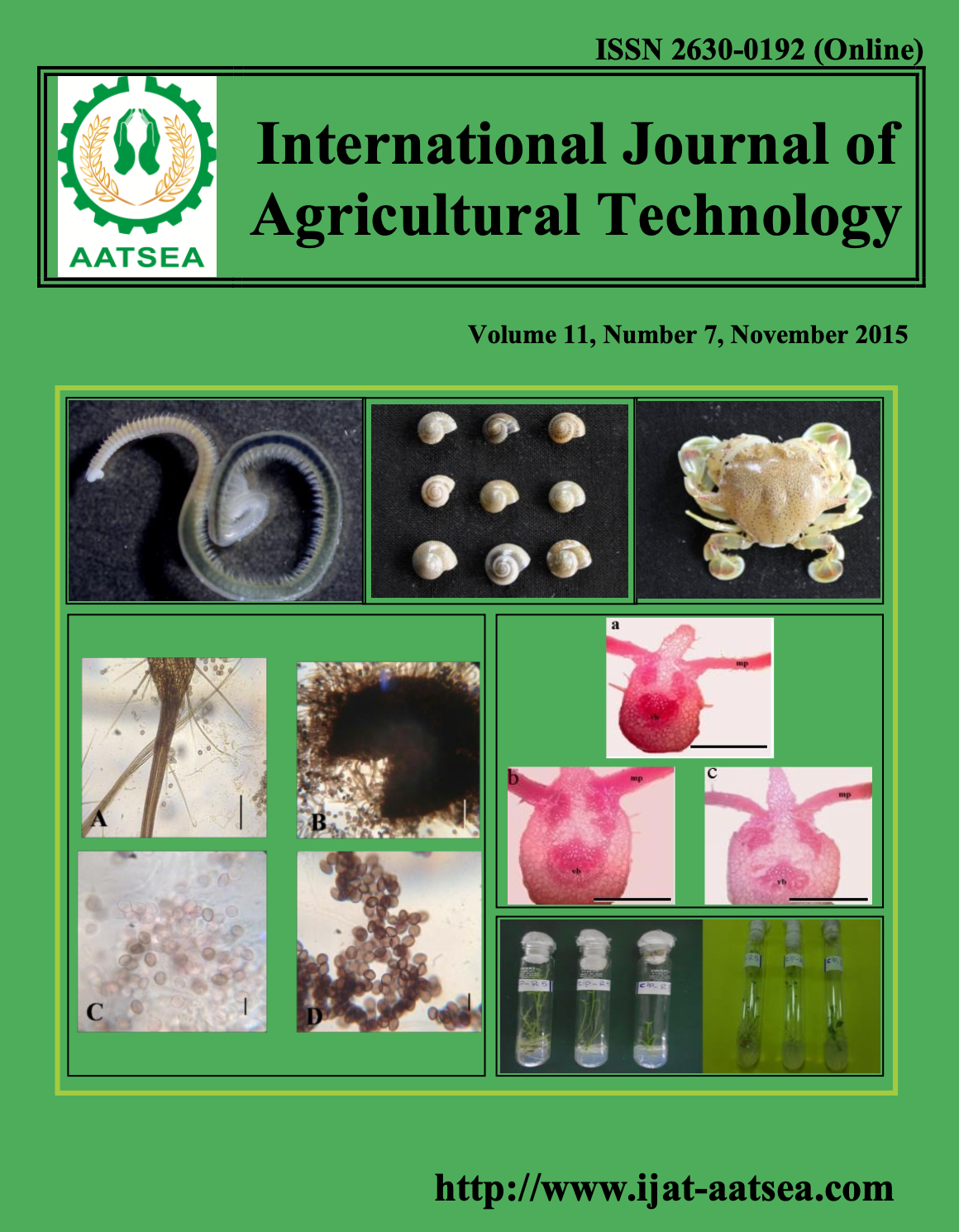Pediculicidal activities of herbal shampoos from Zingiber officinale Roscoe and Camellia sinensis (L.) Kuntze against head louse (Pediculus humanus capitis De Geer:Phthiraptera).
Main Article Content
Abstract
The increasing resistance of head lice ((Pediculus humanus capitis De Geer:Phthiraptera:Pediculidae) to chemical pediculicides has been documented world wide, including Thailand. Moreover, chemical pediculicides have lost their efficacy and thus alternative products such as herbal essential oils, herbal shampoos have been proposed to treat head lice infestation. Therefore, the present study investigated the efficacy of two herbal shampoos based on ginger (Zingiber officinale Roscoe; Zingiberaceae and tea (Camellia sinensis (L.) Kuntze:Theaceae) against head lice and compared them with chemical pediculicide (positive control ; 1% w/w lindane, Hexin Lice Killer®) and baby shampoo (negative control ; Johnson’s baby soft shiny shampoo®) in order to assess their in vitro efficacy.The results showed that all herbal shampoo was more effective than chemical shampoo and baby shampoo with 100% mortality at 10 min. and LT50 values ranged from 0.4 to 1.4 min. and LC50 values ranged from 1.6 to 3.2 µl/cm2. Meanwhile, chemical pediculicide and baby shampoo showed non toxicity to head lice, so 100% of head lice in chemical and baby shampoos groups survived during the observation periods(10 min). Our data demonstrates the high potential of herbal shampoos from Z. officinale and C. sinensis to be used as pediculicides against head lice in Thailand.
Article Details

This work is licensed under a Creative Commons Attribution-NonCommercial-NoDerivatives 4.0 International License.
References
Abdel-Ghaffar, F. and Semmler, M. (2007). Efficacy of neem seed extract shampoo on head lice of naturally infected humans in Egypt. Parasitology Research 100:329-332.
Abdel-Ghaffar, F., Semmler, M., Al-Rasheid, K., Klimpel, S. and Mehlhorn, H. (2012). Efficacy of a single treatment of head lice with a neem seed extract: an in vivo an in vitro study on nits and motile stages. Parasitology Research 110:272-280.
Arab, H., Maroofian, A., Golestani, S., Shafaee, H., Sohrabi, K. and Forouzanfar, A. (2011). Review of the therapeutic effects of Camellia sinensis (Green tea) on oral and periodontal health. Journal of Medicinal Plants Research 5:5465-5469.
Bagaven, A., Rahuman, A. A., Kamaraj, C. Elango, G., Zahir, A. A., Jayaseelan, C., Santhoshkumar, T. and Marimuthu, S. (2011). Contact and fumigant toxicity of hexane flower bud extract of Syztgium aromaticum and its compound against Pediculus humanus capitis (Phthiraptera:Pediculidae). Parasitology Research 109:1329-1340.
Bhargava, S., Dhabhai, K., Batra, A., Sharma, A. and Malhotra, B. (2012). Zingiber officinale: chemical and phytochemical screening and evaluation of its antimicrobial activitie. Journal of Chemical and Pharmaceutical Research 4:360-364.
Burgess, I. F. (2008). Current treatment for pediculosis capitis. Current Opinion in Infectious Diseases 22:131-136.
Burgess, I. F. and Burgee, N. A. (2011). Dimeticone 4% liquid gel found to kill all lice and eggs with a single is minute application. BMC Research Notes 4:1-4.
Burkhart, C. G. (2004). Relationship of treatment-resistant head lice to the safety and efficacy of Pediculicide. Mayo Clinic Proceeding 79:661-666.
Bush, S. F., Rock, A. N., Jones, S. I., Malenke, J. R. and Clayton, D. H. (2011). Efficacy of the louse bouster a new medical device for treating head lice (Anoplura: Pediculidae). Journal of Medical Entomology 48:67-72.
Canadian Pediatric Society (2008). Head lice infestation: a clinical update. Paediatrics Child Health 13:692-696.
Clark, J. M. (2009). Determination, Mechanism and monitoring of knock down resistance in permethrin resistant human head lice, Pediculus humanus capitis. Journal of Asia-Pacific Entomology 12:1-7.
Eisenhower, C. (2012). Advancements in the treatment of head lice in pediatric. Journal of Pediatric Health Care 26:451-461.
Frankowski, B. L. and Bocchini, J. A. (2010). Clinical report: head lice. Pediatrics Child Health 126:392-403
Gur, I. and Schneeweiss, R. (2009). Head lice treatment and school policies in the US in an era of emerging resistance: a cost-effectiveness analysis. Pharmacoeconomics 27:725-734.
Gallardo, A., Mougabure-Cueto, G. and Picollo, M. (2009). Pediculus humanus capitis (head lice) and Pediculus humanus humanus (body lice): response to laboratory temperature and humidity and susceptibility to monoterpenoid. Parasitology Research 105:163-167.
Hasan, H. A., Raauf, A. M. R., Razik, B. M. A. and Hassan, B. A. R . (2012). Chemical Composition and antimicrobial activity of the crude extracts isolated from Zingiber officinale by different solvents. Pharmaceutica Analytica Acta 3:184-189.
Heukelbach, J., Speare, R. and Canyon, D. (2006a). Natural products and their application to the control of head lice: an evidence –base review. In Brahmachari, G (ed.), Chemical of natural products: recent trends and developments, Kerala, India: Research Signpost. pp. 1-26.
Heukelbach, J., Oliverira, F. A. and Speare, R (2006b). A new shampoo base on neem (Azadirachta indica) is highly effective against head lice in vitro. Parasitology Research 99:353-356.
Heukelbach, J., Canyon, D.V., Oliveira, F. A., Muller, R. and Speare, R. (2008). In vitro efficacy of over-the-counter botanical pediculicides against the head louse Pediculus humanus var capitis based on a stringent standard for mortality assessment. Medical and Veterinary Entomology 22:264-272.
Lapeere, H., Brochez, L., Verhaeghe, E., Stichele, R. H. V., Remon, J. P., Lambert, J and Leybaert, L. (2014). Efficacy of products to remove eggs of Pediculus humanus capitis (Phthiraptera: Pediculidae) from the human hair. Journal of Medical Entomology 51:400-407.
Namita, P., Mukesh, R. and Vijay, K. L. (2012). Camellia sinensis (Green tea): A review. Global Journal of Pharmacology 6:52-59.
Rassami, W. and Soonwera, M. (2013a). Pediculicidal effect of herbal shampoo against Pediculus humanus capitis in vitro. Tropica Biomedicine 30:1-10.
Rassami, W. and Soonwera, M. (2013). In vitro pediculicidal activity of herbal shampoo base on Thai local plant against head louse (Pediculus humanus capitis DeGeer.). Parasitology Research 112:1411-1416.


